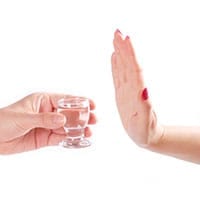Naltrexone is a medication that alters normal function in the brain and body by blocking access to sites called opioid receptors, which appear on the exterior surfaces of certain nerve cells. Originally developed to combat the addictive effects of opioid narcotics such as heroin, oxycodone, and codeine, it is now also used to reduce the pleasurable sensations associated with drinking alcohol and reduce alcohol cravings in recovering alcoholics. The success of naltrexone treatment depends largely on simultaneous use of some sort of psychosocial therapy that can address specific issues surrounding alcohol use in any given individual.
Background Information
In addition to certain areas in the brain, opioid receptors are found in the spinal cord, stomach and small intestine. They exist in human beings in order to provide nerve cell access to a variety of naturally occurring substances—such as endorphins, dynorphins, and enkephalins—known collectively as opioid peptides. When these substances gain nerve cell access, they trigger varying degrees of natural pain relief, general feelings of well-being, and/or a pleasurable sensation known as euphoria. According to findings released in 2012 by researchers at the University of California, San Francisco, the consumption of alcohol triggers a release of endorphins inside the brain. When people consume significant amounts of alcohol, the resulting endorphin release is typically large enough to produce euphoric sensations. These euphoric feelings play a formidable role in the development of heavy drinking patterns and the eventual onset of alcoholism.
Naltrexone’s Effects
Naltrexone blocks access to the opioid receptors by directly occupying them and making them physically and chemically unavailable to all other substances. In people who abuse opioid drugs, use of naltrexone prevents molecules of any given opioid drug from accessing the opioid receptors; without this access, opioids have no way to produce their classic mind- and body-altering effects. For a long time, researchers struggled to understand exactly how a medication designed to block the effects of opioids could also reduce the urge to drink alcohol. However, with the discovery of alcohol’s effects on endorphin release, the scientific picture has clarified considerably. Apparently, naltrexone blocks endorphins from reaching the opioid receptors, just like it blocks opioid drugs. This action effectively reduces the amount of euphoria that alcohol consumption produces in the brain. In turn, without the euphoric effects normally associated with alcohol consumption, alcoholics have less incentive to maintain their alcohol intake. In recovering alcoholics who have already stopped drinking, the presence of naltrexone also decreases the impact of brain changes that support strong cravings for a return to alcohol use.
Conditions of Use
Naltrexone reduces the incentive to drink, but it does not remove this incentive. This is true, in part, because some of the motivation for continued drinking in active and recovering alcoholics is psychological, not physical. For this reason, useful naltrexone treatment typically requires simultaneous participation in some form of therapy. According to the Substance Abuse and Mental Health Services Administration (SAMHSA), three main types of therapy are used in conjunction with naltrexone: supportive, peer group-based abstinence techniques such as those commonly used in 12-step programs; coping skills-oriented techniques such as those typically taught during a form of psychotherapy called cognitive behavioral therapy (CBT); and a combined therapeutic approach that features aspects of both peer-based and CBT techniques. Generally speaking, naltrexone use combined only with peer group support does not contribute significantly to positive treatment outcomes, SAMHSA reports. However, the combination of naltrexone, peer group support and cognitive behavioral therapy does contribute to positive treatment outcomes, as does the combination of naltrexone and CBT alone. Despite naltrexone’s ability to lower the level of alcohol consumption in active alcoholics, doctors typically only prescribe the medication to people in recovery who have already established abstinence, SAMHSA explains. However, unlike people taking another medication commonly used during alcoholism recovery, called Antabuse (disulfiram), people who relapse during recovery can still keep taking naltrexone. In fact, naltrexone appears to produce some of its most beneficial effects by shortening the length of alcoholic relapses.
Side Effects
Relatively mild side effects of naltrexone use can include headaches, insomnia, muscle pain, unusual tiredness, mild abdominal pain or cramping, painful joints, dizziness, appetite loss, restlessness, nausea, vomiting, anxiety, and symptoms that resemble the common cold. More severe potential side effects of the medication include chest pain, confusion, abnormally high urine output, severe abdominal pain or cramping, depression, hallucinations, blurred vision and mood swings, as well as jaundice and a variety of other symptoms related to liver damage. The presence of severe naltrexone-related symptoms needs to be addressed promptly by a doctor.

